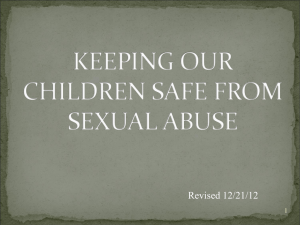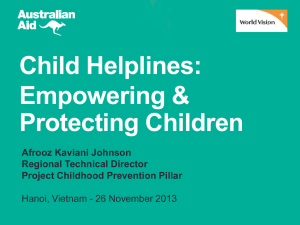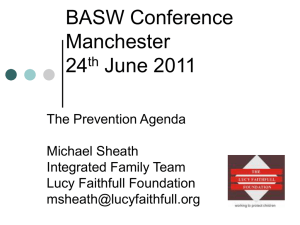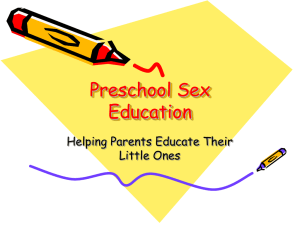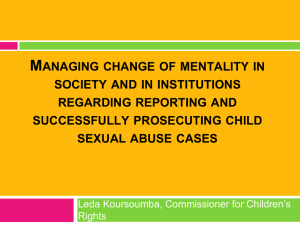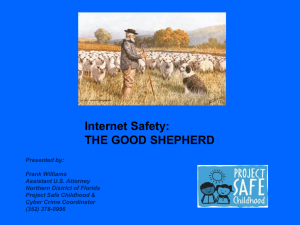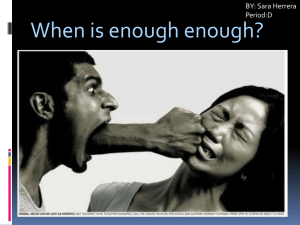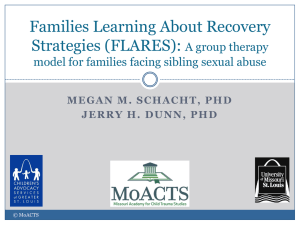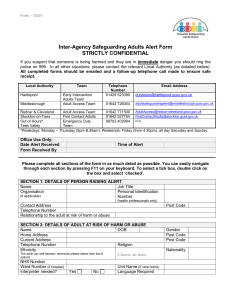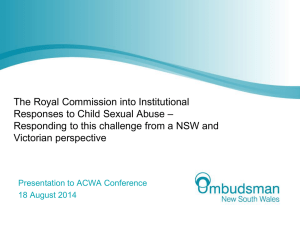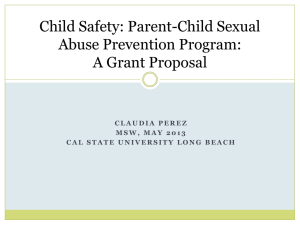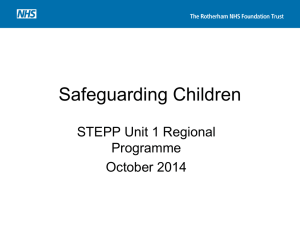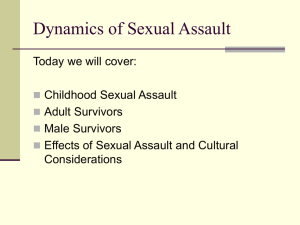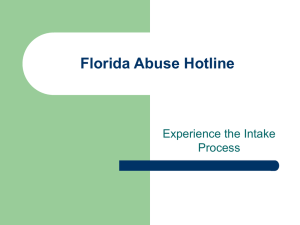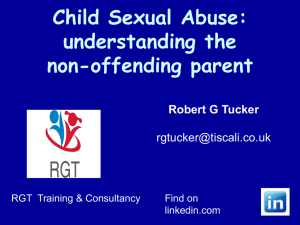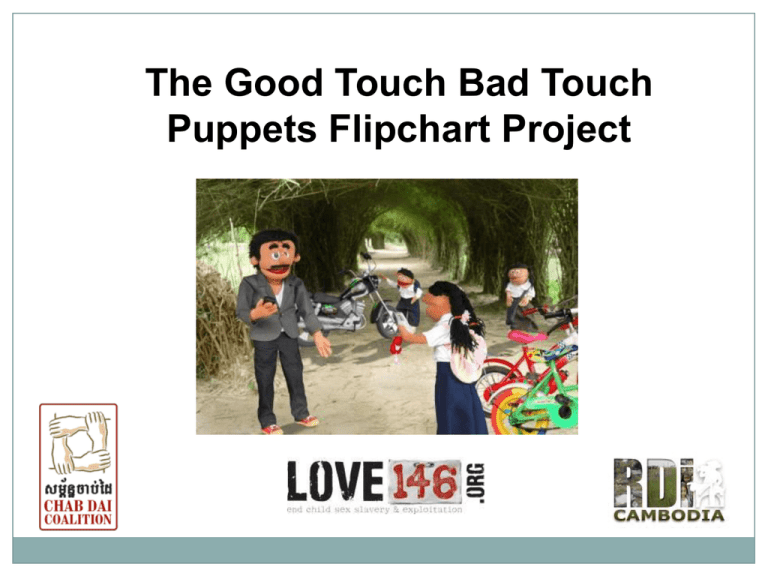
The Good Touch Bad Touch
Puppets Flipchart Project
The Good Touch Bad Touch Puppets Flipchart
Project was developed by the Chab Dai
Prevention Forum as a way of communicating
about sexual abuse and exploitation in a creative
way.
Resource Development International brought the
idea to life through the use of puppets and a
series of photos which tell the story of three
children who all become affected by abuse in
different ways.
Love 146 then initiated a pilot process to test
out the flipchart and develop a quality product
which can now be used across Cambodia.
What is sexual abuse?
Any form of sexual activity
with a child, by an adult or
another child (male or
female) where there is no
consent or consent is not
possible.
Definition of Sexual Abuse: Non-Contact
- exposing children to adult sexual activity and/or
pornography.
- asking sexually intrusive questions.
- making sexual or leud comments about a child’s body.
- having children pose, undress or perform in a sexual
manner for photographs, films or for immediate personal
gratification.
Definition of Sexual Abuse: Contact
- being touched and fondled in sexual areas, including
kissing.
- forcing a child to touch another person's sexual areas.
- sexual kissing or oral sex.
- penetrative intercourse-can be vaginally or anally
with body parts (eg: fingers, tongue and penis)
and/or objects.
Feelings after sexual abuse
Powerlessness and loss of control
"I feel so helpless.
Will I ever be in control again?“
Emotional numbness
"I feel so numb. Why am I so calm?
Why can't I cry?“
Denial
"Was it really abuse?
I'm okay. I'll be alright.“
Disturbed sleep
Flashbacks
Guilt/self blame
"I feel as if I did something to make this happen. If
only I hadn't.....“
Embarrassment/shame
"I feel so dirty, like there is something wrong with
me now. “
Loss of confidence
"I feel I can't do anything any more....even the
simplest things.“
Fear
"I'm constantly jumpy. A sudden noise,
an angry voice and I am afraid.“
Mood changes
"I feel like I'm going crazy!“
Low self-esteem
"I'm disgusted by myself, by the memories.
I'mjust worthless.“
Depression
"How am I going to go on?
I feel so tired and hopeless.“
Anxiety
"I feel so tense. I'm a nervous wreck.“
Hostility
Anger
"I want to kill him; I hate him, everything, everyone.“
Fear of physical contact
"I just can't bear to be touched“
Alienation/isolation
Other signs of sexual abuse
Injuries to anus or genitals
Headaches, stomach aches
Sudden loss of appetite
Wetting the bed
Lack of personal hygiene
Running away
Inability to concentrate
Acting out
Self-harm
Aggression
Overtly sexual behaviour
Masturbation
The Grooming Process
Subtle steps
- Perpetrators select children who appear to be sensitive,
insecure, quiet, passive and/or curious.
- They often gain access through the family or
neighbourhood.
- Some use understanding, affection and love to gain the
child’s trust.
- Some use bribery or gifts.
- The first physical contact is usually “accidental” touching
then the child can be manipulated through increasing
levels of sexual talk and touching.
-With boys especially, often pornography, drugs
and/or alcohol are used to get them to comply.
-The perpetrator may rationalize the abuse by
saying it is sex education or a common
expression of love.
- As abuse progresses, the perpetrator often uses
threats of violence or exposure to silence the
child.
-Violence can escalate if the child is resistant .
- In the worst case scenario, a perpetrator will kill
the child to cover the abuse.
Boys and abuse
Discussion points
- The male victim and ideas of masculinity.
- The dangers and effects of abuse.
- Reactions to boys who have experienced abuse.
- The practice of fondling young boys’ genitals.
- The challenges of working with boys.
- The support needs of boys.
Dealing with disclosures
DO..........
- Ensure the discussion is in a safe, quiet place, preferably in
sight of another adult.
- Immediately tell the child you believe them.
- Tell them they were right to tell you and brave to do so.
- Use the child’s language or vocabulary.
- Speak softly and calmly.
- Maintain eye contact and have a safe posture
- Acknowledge that it is difficult to talk about such things.
- Listen, listen, listen, listen.
- Tell them they are not responsible for what happened.
-Tell them that sometimes adults do things that are not
OK.
-Do everything you can to support and reassure the
child.
-Tell the child what you are going to do next.
- Reassure the child that you will only tell people who
can help and not other children.
- Ensure the child feels safe following the disclosure.
DON’T.........
- Make promises you cannot keep.
- Panic or show that you are shocked.
- Give the impression that you may blame the child.
- Ask intrusive questions or suggest answers.
- Touch the child unless you ask permission and only on safe parts
of their body.
- Attempt to investigate or confront persons accused in the
disclosure.
Creating a safe environment
Anticipating questions
Child Protection Policy
It is important that you have read the Child
Protection Policy of your organization.
By reading it you will ensure that:
-you are familiar with the beliefs and commitment of your
organization.
- you are familiar with its screening and selection process.
-you are aware of the appropriate codes of conduct.
-you know how to report a disclosure.
- you know how to communicate about children.
Self-care
- Ensure you have a manager to talk to
after a disclosure as it is likely to have
an impact on you as well as the child.
- Ensure you know how and where to
refer to before a child discloses.
- Do not start training until you have
things in place to support the child
and you.
Quiz - review
1.
A perpetrator is normally a foreigner and/or
a stranger.
2.
Most incidents of sexual abuse are reported
to the authorities.
3.
Boys rarely get abused and if they do, they
are stronger than girls in dealing with it.
Quiz - review (cont)
4.
Children often find it difficult to express what
they feel/need to adults as they are not used to
being asked.
5.
Having a support system in place for making
referrals is essential when working with
children.


